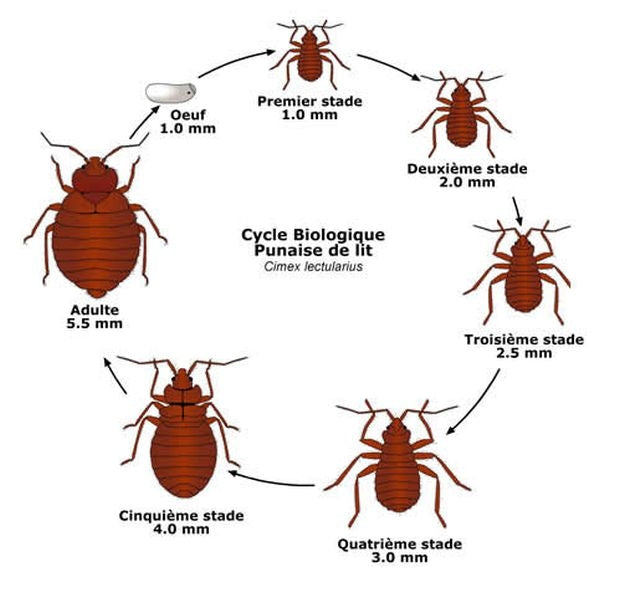Bed bugs - Recognizing and getting rid of them?
Bed bugs are small domestic insects that are extremely difficult to get rid of in the home.
How do bedbugs infest a home?
A bedbug infestation often occurs in areas where conditions are conducive to breeding and feeding.
These pests spread easily from one place to another, making control and elimination particularly difficult. People are at the heart of the problem and the solution when it comes to managing a bedbug infestation. Their ability to detect signs of infestation early and act quickly is essential to limiting the spread of these pests.
How do bed bugs stay alive?
Bed bugs, small nocturnal insects, feed mainly on human blood, preferring the dark and hiding in hard-to-see places during the day. As insects, they have developed sophisticated strategies for surviving in hostile environments, including resistance to certain pesticides, which further complicates their eradication.
How do you know if you've got bedbugs?
They suck the blood of humans at night, causing minor skin rashes and itching in 85% of their victims..
Tiny and flat-shaped, bed bugs are easily camouflaged during the day and attack at night. In the vast majority of cases, an exterminator is needed to eliminate them completely. But while you're waiting for an exterminator (or the money to hire one), you can manage the presence of bedbugs so that, temporarily at least, they'll let you sleep.
Where do bedbugs hide?
Bed bugs often hide in hard-to-see places, such as mattresses, bed frames, and cracks in furniture.Regarding health, the impacts of bed bugs can range from simple skin irritations to more severe allergic reactions.
Bites, generally recognizable by their alignments or groupings on the skin, serve as an indicator of the possible presence of these pests. People may not immediately realize that they are victims of bedbugs, as these insects generally feed at night.
Furniture, especially beds and sofas, offer ideal hiding places for these pests.
An infestation can quickly spread through bedrooms and beyond, making eradication more difficult. The bed is the epicenter of bedbug activity, giving them easy access to their food source while the host sleeps.
Finally, detecting bed bugs in your environment is the first step towards controlling and eliminating these invasive pests.
Bed bug prevention and health tips
- Wash and dry all fabric items in hot water and place in garbage bags until all items have been washed and the following steps have been completed (i.e. take care of the following steps during washing).
- Apply baking soda to carpets, mattresses, fabric furniture and the base of walls, then leave for at least an hour.
. - Vacuum wherever baking soda is present, paying particular attention to mattresses and fabric furniture.
- In a spray bottle, mix lavender essential oil (30 drops) and Testree essential oil (30 drops) with 80 ml of water. Then spray the lavender mixture absolutely everywhere in the home, especially on mattresses and fabric furniture.
- Put washed clothes and fabrics away, then spray them with the lavender mixture.
- Taking a bath with a few drops of lavender oil before bed reduces the risk of stings and itching.
- Insecticides can be harmful in the long term, especially to children, so be very careful if you decide to use them.When you decide to call in an exterminator, make sure their services are covered by a warranty. Bed bugs are very persistent, so better safe than sorry!
Health prevention
Bed bugs hide in mattress seams and crevices. Inspect these areas regularly to spot them. Bed bugs travel via luggage and clothing. To prevent infestation, wash your clothes at high temperature, as you would after traveling.
Health can be affected by bedbug bites. Keep clean and vacuum frequently to reduce the risk. Sleep is disrupted by bedbug invasions. Use bedbug covers to protect your bed.
Blood attracts bedbugs, making bites frequent. Treat quickly to reduce the inconvenience. Bites often indicate a problem. At this stage, professional extermination may be necessary. Infestation spreads rapidly without intervention. Act at the first sign to prevent their proliferation.
Prevention means constant vigilance. Check your bed regularly and use natural repellents.
How can people combat bed bugs?
Bed bugs represent a major domestic pest challenge, requiring targeted intervention to eradicate them. Pest control products, including sprays and powders, are essential tools in this fight, making it possible to effectively eliminate these pests.
At the same time, physical methods such as intensive cleaning and the use of heat help to combat infestation without resorting to chemical substances. Heat treatments, which expose bedbugs to lethal temperatures, are a powerful option, but require the intervention of professionals for safe and effective application.
Together, pest control treatments combine these chemical and physical approaches for a complete solution. Finally, pest control against bed bugs requires an integrated strategy, combining different treatments to ensure total eradication and prevent future reinfestation.
Clothes must be cleaned
Bed bugs hide in clothing and linen, requiring thorough cleaning to prevent their spread. Health is threatened by their bites, which can cause itching and allergies. Those affected need to wash their textiles at high temperatures to eliminate these parasites. Furniture, especially beds, is a prime breeding ground for bedbugs; cleaning these areas reduces the risk. In short, combating bed bugs requires rigorous hygiene of textiles and furniture to protect health and the living environment.
Source


